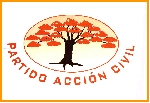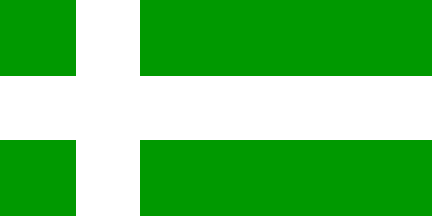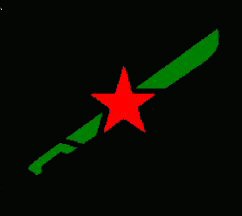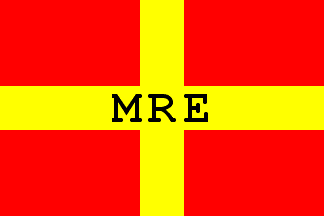
image from <home.coqui.net>

Last modified: 2015-01-23 by zoltán horváth
Keywords: puerto rico |
Links: FOTW homepage |
search |
disclaimer and copyright |
write us |
mirrors
See also:
Other sites:
Puerto Rico is not a state or a territory of the US; it is a
voluntarily associated free state ("estado libre
asociado", I believe is the official title.) Their citizens
are US citizens and they use US currency, the US handles foreign
affairs and defense, but they are internally self-governing. They
have no voting representative in Congress (however someone does
serve on committees and can speak on the floor) and do not pay
income tax (not to Washington, anyway; I don't know the local tax
structure.) Puerto Rico has its own Olympic committee and participates
under its own flag there and at the Pan American games etc. There
is a prominent statehood movement and a small independence
movement; the shades of blue in the Puerto Rico flag supposedly
distinguish these folks.
Al Kirsch, 23 March 2003
On the Puerto Rico statehood issue, there is a serious
pro-statehood movement on the island. The last vote on the
future status of Puerto Rico in 1998 offered five options, of
which three got significant support: statehood, 46.5%;
independence, 2.5%; "none of the above," 50.3%.
"None of the above" was supported by the party that
supports continuation of the present commonwealth status and was
widely interpreted as a vote for the status quo.
Joe McMillan, 24 March 2003
Puerto Rican independentists, associated republicans, and
almost every one else agree that the actual flag shall never,
never be replaced by another design, except for the explained
blue tone of the triangle issue.
Blas Delgado Ortiz, 21 February 2005
I am from the beautifull island of Puerto Rico. To make the
story short, Our flag is based exactly on the flag of Cuba, only difference change the color
of the triangle and the stripes to the opossite. Being the
Cuban flag with light Blue Stripes and Red Triangle our
flag should be light blue Triangle and red stripes. Also your
display of the Cuban flag is wrong, their flag is Light Blue and
you can verfy that anywhere.
The problem of different color for my flag resides in History and
how it can be manipulated by political forces. When my
country got invaded by US forces, the posesion of a Puertorican
Flag was a crime punished by death and prison. We had a military
based govermenth till 1952, when we elected or First Governor
Hon. Luis Munoz Marin and with the consent of the US goverment
the "Estado Libre Asociado" Commonwealth was
established. Because of an error when the ordered the Flags to be
displayed in New York they used Navy Blue as the american flag
instead of light blue, but thay had to be displayed!
The thing is that as you should know, ther is 3 political parties
here. One seeking Statehood, Other to stay as we are, and the
last one to be Independent.
The thing is that those that seek statehood, change the flags
form light blue to navy blue when they get into Government. That
to make it look as the American Flag. So they express that the
light blue is used only by the people that seek independence
(which is not true). That is only to justify their use of the
navy blue, which is not valid. The official flag was and still is
the one with the light blue.
Rafael Linero Rivera, 2 July 2001
My impression is that until relatively recently, blue was
blue--not just in the Puerto Rico flag but in general. I
don't believe there was anything sinister or even implicitly
political in the flagmakers in the US (or in US-owned PR) using
the same shades of red and blue as prescribed for the US
flag. That's standard practice for US flagmakers
generally. The different shades of blue, I believe, have
only acquired political meanings relatively recently, but I can't
swear to that. As for the Cuban flag, my understanding is
that the blue is rather a bright than a light blue--certainly not
as dark as US or UK blue but darker than Argentine celeste.
But again, that's an impression, not a statement based on
documentation or certain knowledge.
Joe McMillan, 2 July 2001
It is interesting to read the article, weather is has some
ground or not. It has not been unknown that similar
"small" distinctions, quite unimportant and neglectable
to a casual observer, are give large political significance
(weather true or alleged). Blue shade of a field is especially
well suitable for such purpose, since often, blue is not exactly
defined by legislation, but the different shades of blue used are
very easily differentiated. However, I for one would be very
careful about this claims, as they sound very close to
"urban legend". There is a number of such
"legends" about more or less every flag. On the other
hand, it may well happen that various political streams that all
claim right to one and the same symbol do find small and
substantially unimportant (or historically undifferentiated)
element that may serve as identification to those
"initiated". Weather this is done in purpose and
systematically, or if it is only a practice observed on
preferences of large number of users, it is not quite important.
I suspect that it may well be the case with the shades of blue of
Puerto Rico.
Željko Heimer, 2 July 2001
Much of this may be urban legend. I have heard it reported
that those who favor independence favor (and perhaps display)
light blue, those who favor "Commonwealth" (present)
status favor a medium ("royal"?) blue, and those who
favor statehood favor a dark ("navy" or "old
glory") blue. True?
As for the Cuban flag, I have seen many in South Florida and one
on a Cuban freighter in Toronto harbor. The one on the freighter
used a dark blue. The ones I've seen here use a medium to
medium-dark shade. Never have I seen a Cuban flag in light blue,
if what is meant is a shade anywhere in the range of Argentina's
very light blue to Britains's RAF Ensign to Sweden's at the
darker end (which is still lighter than "medium" or
"royal".). So Mr Linero may need some straightening out
here.
As for the politically charged nature of this, I don't think
anyone here is about to take a stand one way or another on PR's
legal status.
Al Kirsch, 3 July 2001
I reside in Puerto Rico and I can tell you that the only flags
displayed in commercial and government buildings are the navy
blue and royal blue varieties. I suspect royal blue can be called
the "official" one as it predominates in government
buildings. Sky blue variants have been very limited to
independence groups, which comprise about 5% of the population. I
have to add that this has become a charged issue during the past
weeks as PR as undergone was is called as the "War of
Flags" between various political groups. Indepence groups
have been planting sky blue PR flags near US military
installations, while pro- statehooders have been showering the
roads and streets with US and either dark or royal blue PR flags.
Rafael Linero Rivera, 6 August 2001
In 1995, during the pro-statehood government of Gov.
Rossello', the royal or medium blue flag was made the official
flag of PR, replacing the Navy blue one. The Navy blue flag was
adopted in 1953 by the Commonwealth government of Gov. Muñoz
Marín to match Old Glory as both flags were officially flown
together for the first time since the USA occupation of 1898. It
is ironic that a pro-statehood government chose the same flag
that was previously ban for generations by both countries as a
symbol of rebellion and independence. The sky-blue flag, has
never been recognized as an official flag. But, it is true that
it has been used recently by pro-independence sympathizers. It
was made that way to make it as far likely as possible to the USA
flag. Two very big flags has been posted at Vieques and Cayey.
The blue color of the Cuban flag was never intended to be
sky-blue. It is not in the Coat of Arms. Neither it was to be
Navy blue. It is a medium to medium-dark blue. So, when people
say that the PR flag was inspired by the Cuban flag, only the
colors reversed, they are really referring to the now official
royal blue version, not the sky-blue flag. But this issue is very
controversial in PR, and the faded one theory of both the Cuban
and PR flags has many sympathizers here, due in part to our
present political situation and the confrontation with the US
Navy.
Blas Delgado Ortiz, 6 August 2001
The blue on the Cuban flag is a medium blue, a lighter blue
than the US flag. The flag of Purto Rico is derived from
the Cuban flag by switching the red with the blue.
Therefore the blue on the Puerto Rican flag is also medium
blue. Or it would be, except for politics and circumstance.
The Puerto Rican flag was officially considered seditious for
half a century. Then in 1952 it became the official flag of
the Commonwealth of Puerto Rico. Dyes fade in the sun, so
the US government makes new flags dark. The initial run of
new Puerto Rican flags used the same "Old Glory" blue
as found in the US flag. I don't think there was any
political statement intended. In vexillology, the usual
rule is that shades don't matter (again, because flags fade).
But some people have made the shade of blue a political issue,
and at some point the Puerto Rican government officially stated
that the triangle on the Puerto Rican flag is medium blue.
Randall Bart, 2 July 2003

image from <home.coqui.net>
Partido Accio'n Civil (Civil Action Party):
The portrayed tree is known as a "flamboya'n" or royal
poinciana (Delonix regia). Its bloom is bright orange. According
to the site, "our emblem [badge] is a royal poinciana in
bloom, for it symbolizes an improved environment and thus shall
we reforest our society..."
J. Vaquer Jr., 4 March 1999

image by Phil Nelson , 24 January 2000
based on image from <www.pip.org.pr>
Last night I saw on the news another attempt for a referendum
on statehood or independence (or maintain status quo) will be
held in Puerto Rico this year. In the news clip there was a
flag-frenzy of US flags, Puerto Rican flags, and at some (to me)
UFE's. There were so many flags, it was tough to distinguish, but
I think that one of the UFE's is: Green, white cross, as in St.
George's cross (I'm pretty sure of this one)
Rob Raeside, 5 March 1998
Green & white is the flag of the Independence Party
Anna Stone Jimanez, 31 October 1998
Could any of you do me the favor of explaining the origin and
meaning of the flag of the Puerto Rican Independence Party (PIP):
vert a Scandinavian cross argent? It appears in FLAGS THROUGH THE
AGES in one of the pages dedicated to symbols of political
parties, but regrettably no commentary is included.
Juan Morales, 25 Febuary 1999
Pending more information directly from the Puerto Rican
Independence Party <www.pip.org.pr>
:
The green background aludes to the island of Puerto Rico,
reflecting the field tincture of the national CoA granted by
Spain on November 8, 1511. It has also been identified with
patriotic hopes. The white cross honors the Christian democratic
roots of the party at its inception in 1946.
The layout honors the Rebel Flag of Lares
an inland town wherein an unsuccessful rebellion was prematurely
staged against the Spanih government in September 23, 1868. The
Lares flag, intended to become the national flag of the Republic,
was designed by Dr. Ramon Emeterio Betances and embroidered by
Mrs. Mariana "Golden Arm" Bracetti. This layout in turn
honors their liaison to the Antillean Confederacy and nationalist
forces in the Dominican Republic, where Dr. Betances had been
exiled to. Although in 1971 (?) the Puerto Rican Indenpedence
Party adopted democratic socialism as the cornerstone of its
platform, the party emblem was created decades before this
political redefinition. The flag's layout is not purposefully
related Scandinavian vexillology, despite the party chairman's
political and former matrimonial links to Sweden. Albeit the
official flag bears no charges, other versions of the flag have
charged it with:
- a right fist holding a rose, all ppr, the symbol of the
Socialist International
- the party's motto: "Independencia, Socialismo,
Democracia" (Independence, Socialism, Democracy) in black
- the national coat of arms of Puerto Rico
- the national seal of Puerto Rico
- the head of the Statue of Liberty (in New York) bearing a flag
of Puerto Rico across its forehead
- images of four Nationalist Party revolutionaries held in US
federal prisons for a deadly shootout staged at the American
capitol in 1954
- images of the pantheon of Puerto Rican independence heroes
- a map of Puerto Rico
- the coqui' (Eleutherodactylus portorricensis), a native tree
frog, usually depicted green or tan
- other slogans and charges incidental to specific celebrations
and activities
Juan Vaquer Jr, 26 Febuary 1999

image from <www.tkb.org>
Los Macheteros (official name: Ejército Popular de Boricua
(EPB)), known also as EPB Movimiento Popular Revolucionario,
Machete Wielders and Popular Army of Boricua.
Founding Philosophy: The Macheteros issued their first communique
on August 24, 1978. In the letter, the group protested the deaths
of two Puerto Rican independency advocates by Puerto Rican police
officers. In addition to the written protest, the newly formed
group physically retaliated against the Puerto Rican police
force. The Macheteros first recorded terrorist action was the
murder of a Puerto Rican police officer.
The Macheteros is a terrorist group committed to full Puerto
Rican independence from the United States. While the group has
shown activity in the continental U.S., the group is based in
Puerto Rico. Furthermore, the majority of its attacks have
occurred in Puerto Rico. The Macheteros believe that the U.S. is
illegally occupying Puerto Rican lands. The group's terrorist
activities are particularly aimed at U.S. military installations
and personnel. In addition, the group has a history of attacking
Puerto Rican police officers.
Current Goals: While the Macheteros are based in Puerto Rico, a
bank robbery in the United States precipitated a severe blow to
the terrorist group. In September 1983, the Macheteros stole more
than $7 million from a Wells Fargo bank in West Hartford,
Connecticut. While the Macheteros escaped with the majority of
the stolen money, enough evidence was gathered from the bank
investigation to arrest several key Macheteros leaders.
Despite the successful conviction of several Macheteros leaders
in the early 1990s, the Macheteros have engaged in terrorist
attacks since the arrests.
Source: <www.tkb.org>.
Esteban Rivera, 4 July 2005

image by Ivan Sache, 12 June 2014
The new party of Puerto Rico, Movimiento de Reunificacion con España, has a
flag: red with a yellow cross and the letters MRE in black in the center.
Source:
http://www.naciodigital.cat/noticia/70013/reclamen/reunificacio/puerto/rico/amb/espanya
- Nació Digital, 11 June 2014
Jaume Ollé, 12 June 2014
The MRE is a citizen's movement campaigning for "reunification" with Spain.
They want to be "the 18th autonomous community of a country they never
asked to leave". The MRE recalls that Puerto Ricans "were Spanish citizens until
to the invasion of the island by the USA in 1898". José Nieves, the leader
of the MRE, said that he would apply at the The Hague Court to obtain the
nullification of the Treaty of Paris (1898) that transferred Puerto Rico,
the Philippines and Guam from Spanish to US sovereignty. Nieves, of
Canarian and Catalan origin, believes that the Puerto Ricans will be
readily accepted by the Spanish people. The MRE, established on 13 February
2014, expects to held its first assembly in July 2014.
Source:
http://reunificaciondepuertorico.blogspot.fr/2014/02/bienvenids-la-pagina-oficial-del.html
The flag of the MRE was unveiled on 1 June 2014 in Río Piedras (San Juan).
Source:
http://reunificaciondepuertorico.blogspot.fr/2014/06/nuestra-bandera-es-una-realidad.html
- MRE blog, 1 June 2014
The flag is modelled on the flag used in Puerto Rico
during the 1st Spanish Republic.
Ivan Sache, 12 June 2014